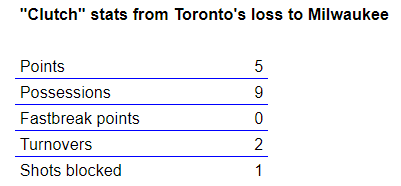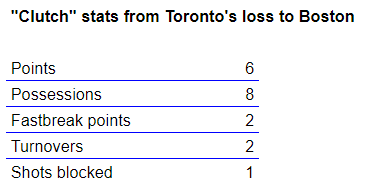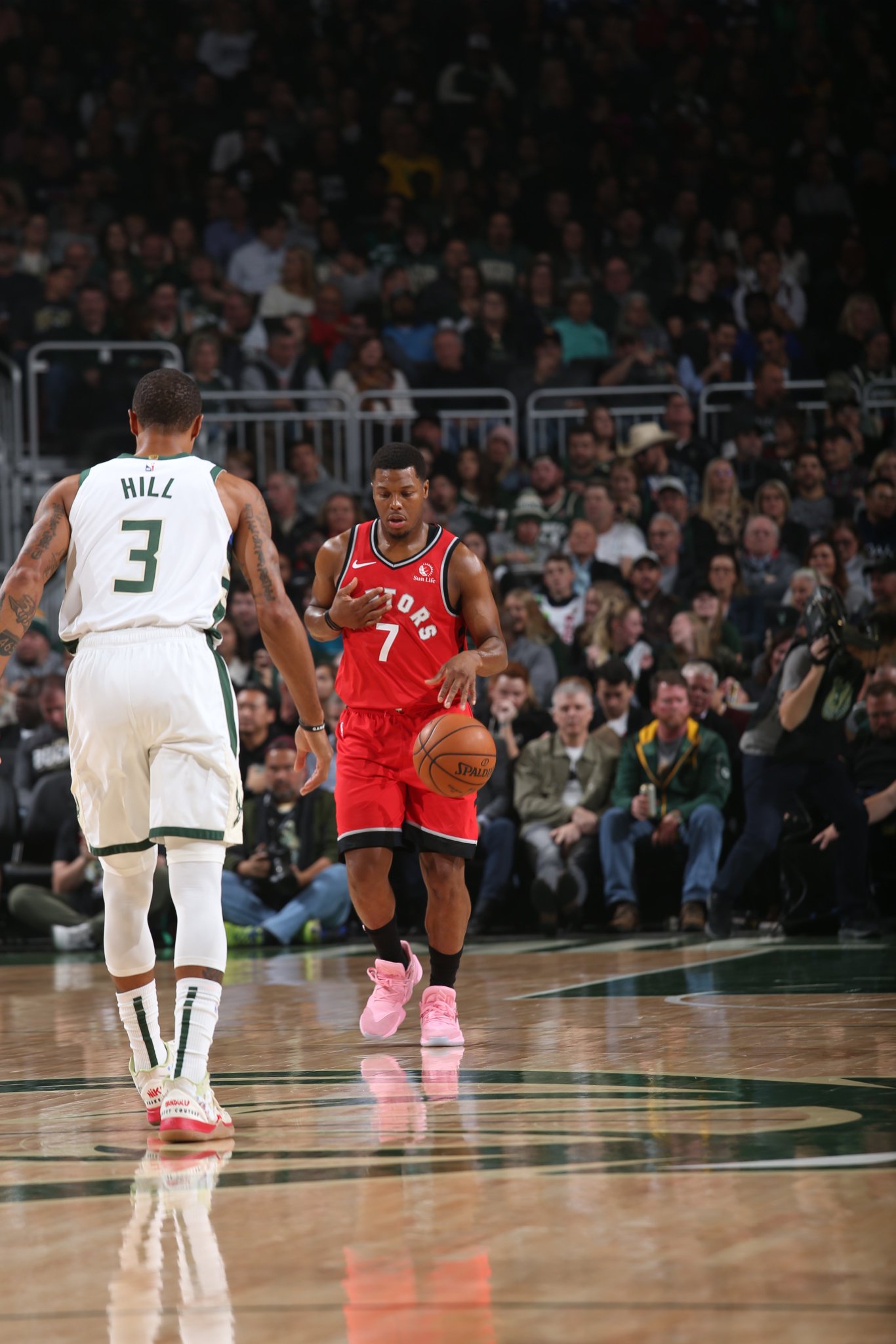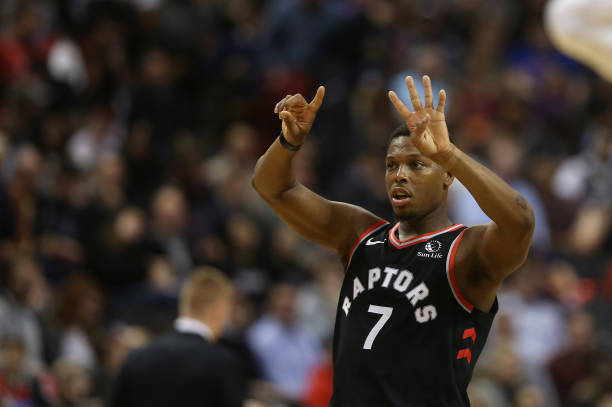Basketball games, like people, can wear many faces. Toronto’s 115-105 loss to the Milwaukee Bucks on Saturday night could be best remembered for the Raptors’ slow start. The loss could be best defined by Toronto’s storming comeback, which turned a 26-point deficit into a close game, although they failed to eventually win. Kyle Lowry’s 36-point eruption, drilling pull-up jumper in transition after pull-up jumper in transition, could, similarly, be the definitive narrative of the game. But for Toronto’s purposes, the failure of the offense when the game mattered could be what best predicts the Raptors’ success — or lack thereof — going forward.
Using a fairly arbitrary starting point of five minutes remaining in the game, and the ending point of when the game was no longer competitive, the Raptors were beaten by the Bucks by five points. Their offense struggled, most of all. Here are some of the key numbers from those minutes of Toronto’s loss.

Toronto’s offense struggled. They had as many turnovers as made field goals. Much of that was because there was no single player to whom the Raptors could turn for a high-value shot on every possession. Though Lowry was brilliant throughout the night, his performance in the final minutes vacillated. He had an assist to Marc Gasol for one of Toronto’s buckets, but his creation in the pick-and-roll was haphazard. That wasn’t really Lowry’s fault; the Raptors ran three pick-and-rolls in clutch time, and they yielded absolutely nothing.

The problem is that opponents can safely ignore Gasol as a scoring threat when he’s involved in main actions. He offers so little of his own scoring ability, aside from spot-up 3-point shooting, that opponents can swarm the ball-handler and force turnovers when Gasol pulls his defender towards the ball.
When Milwaukee gave Gasol relatively straightforward attempts in those same actions, he didn’t convert.
Gasol did contribute well to the offense when he was used off-ball. This clever play saw a brush screen from VanVleet on Lowry’s defender to force Milwaukee’s weaker guard defender onto Lowry. With Lowry thus more threatening, he drove and occupied the defense’s attention. Meanwhile, Gasol back-screened for Siakam, and when the defenders tried to shoot the gap to take away Siakam’s spot-up shot, Gasol could easily slip for a layup.
This is smarter basketball, based more on guile and feel than brute force. That’s where players like Lowry and Gasol thrive. Toronto needs to force defenders into multiple decisions on an offensive set, and a simple 1-5 pick-and-roll doesn’t do that. The more decisions defenders have to make, the more opportunities there are for mistakes.
Toronto does have a uniquely talented scorer at the power forward spot in Pascal Siakam. Siakam should have been able to pick up the slack and create shots on his own; however, that didn’t happen against Milawukee. In his one isolation play, he wasn’t able to convert in isolation against Antetokounmpo.
Against most defenders, that’s a good look. Antetokounmpo alone is so long and fleet of foot that he’s able to contest Siakam’s spin despite overplaying Siakam towards the middle of the floor. For any other player in the league, Antetokounmpo’s defensive positioning in that play would have been death against Siakam, but Antetokounmpo is unique. He’s crafted almost perfectly to defend Siakam without help.
When Toronto did find success with the ball in Siakam’s hands was when they used dynamic plays to create advantages. It didn’t have to be complicated, but Toronto’s only other clutch bucket against Milwaukee came on a Siakam post-up. Instead of Siakam attacking Antetokounmpo alone, OG Anunoby cut and created several advantages. He kicked the ball to VanVleet for the open shot, snatched the offensive rebound, and hit VanVleet again for the make.
This is simple offense, but it highlights the strengths of several Raptors: Siakam’s passing, Anunoby’s cutting, and VanVleet’s shooting. Gasol and Lowry are both used as strong-side spot-up shooters, also highlighting some of their strengths.
It would be easy to say that Siakam was guarded by Antetokounmpo, so the Milwaukee game isn’t indicative of how Toronto will usually play in the clutch. Siakam won’t always have perhaps the best defender in the league, most capable of guarding him in single coverage, draped on his hip. One would expect his clutch performances to improve against any team other than Milwaukee. However, we can turn to Toronto’s performance in its only other close game of the season, against the Boston Celtics. Siakam’s presence was not enough to create efficient offense in that one, either.

Toronto had a similarly low scoring rate and high turnover rate against Boston in the clutch. The Raptors lost those clutch minutes by three points against Boston. Though many of the same problems were on display, including Gasol’s lack of threat as a scorer, there were some positives. For one, the Raptors were able to get one transition bucket, with Lowry throwing a long outlet alley-oop to Siakam. The only other field goal the Raptors scored was on a play that similarly leveraged many of the offensive strengths.
The Raptors may have whiffed on four of five screens set on that play, but at least they got the defense moving. The Raptors don’t have enough talent to run static sets in clutch time; dynamism, even when poorly executed, as in the play above, has a higher chance of forcing mistakes from defenders.
It’s possible that Siakam has only been unlucky thus far in the clutch. Toronto has such a small sample size, fewer than 10 minutes total, and one make here or there changes entire results. For example, if Siakam had made this, the Raptors’ numbers look different against Boston.
It’s important not to overreact as a result of small numbers. No hard and fast conclusions can yet be drawn. Nick Nurse, for his part, said at practice on Monday that the execution has been great, even if the results haven’t. He brought up a Gasol layup that was blocked, which was more a result of great defensive execution than anything else. This early in the season, the process matters far more than the results, and Nurse doesn’t have an issue with the process.
Still, Toronto has displayed a losing trend so far in close games, and that doesn’t mean nothing. The Bucks revealed a number of weaknesses. The Raptors don’t have any offensive players without weaknesses, and even though many of their youngsters have taken big leaps, they still need certain sets to maximize their usefulness.
There are reasons why coaches use static rather than dynamic offenses in the clutch. Much of clutch offense across the NBA comes down to having a single player who can score in seemingly impossible situations. Kawhi Leonard could do that. The Raptors haven’t so far given Siakam a chance to replicate Leonard’s performance in the clutch — partially because of foul trouble — but it doesn’t mean he can’t. And the Raptors should try. There are downsides to not giving a star the ball and getting out of the way. For example, the Raptors’ huge turnover rate in the clutch is almost entirely due to the team trying to play motion offense in high-leverage minutes against set defenses. There’s a reason coaches choose hero ball in the clutch; it doesn’t result in turnovers. And turnovers, more than missed shots, are why the Raptors lost in the clutch against Boston and Milwaukee.
The Raptors came out flat against the Bucks, but that doesn’t reveal much other than early-season malaise. Lowry was, as is his wont, above everything, but that doesn’t reveal anything that we didn’t already know. The Raptors couldn’t score in the clutch, and that is something we didn’t know. The Raptors have plenty of time to fix problems, and Siakam could solve everything if the Raptors give him a massive usage rate in crunch time, but it’s something to pay attention to going forward. The Bucks got their regular season revenge. Now it’s on the Raptors to make sure it doesn’t happen again.



